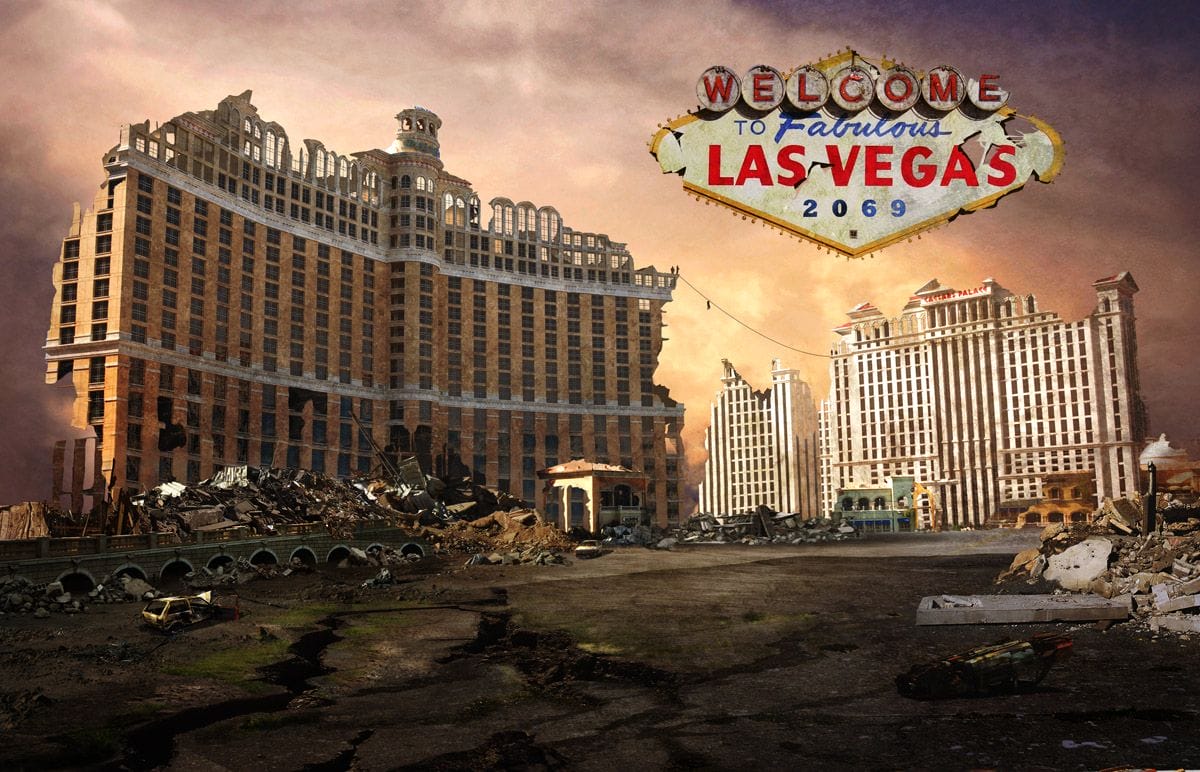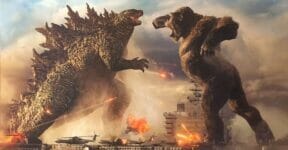We’ve seen Las Vegas being destroyed by zombies at least twice. First, in Resident Evil: Extinction and second, in Army of the Dead. There was also a time when Sin City was hit by a super flu pandemic in the TV adaptation of The Stand, turning a lively neon-riddled gambling center into a ghost town half-buried in sand, sprawling with scumbags and criminals. In Blade Runner 2049, all the neon lights were overshadowed by the orange glow of radioactive air. Even Godzilla found the time to set foot on the Strip and wreaked havoc in the most desultory manner imaginable. But none of those painted a gloomy picture of post apocalyptic Las Vegas.

For once, let’s just ignore what kind of apocalypse that swept through the city and simply focus on the fact that everyone died in its wake. We’ll also not take into consideration when the apocalypse happened. One of the best references we have is, unfortunately, History’s Life After People: The Series, episode Sin City Meltdown. Words of caution: there might be some inaccuracies just like in many other shows on the channel. But then again, there isn’t any peer-reviewed journal about a real post-apocalyptic world because, to everybody’s surprise, the apocalypse hasn’t really happened yet. So, here we go. How will Las Vegas stand the test of time with no one to keep the lights on?
Day 1
Las Vegas is quiet, perhaps for the first time in a century. Besides the actual dead people lying in the streets, hotel rooms, bars, and under some bridges, all the wax figures in Madame Tussauds show no signs of life either. They remain intact, however, because the temperature control is still running and keeping the museum at a cozy 70-degrees.
Day 2
The apocalypse, whatever it might be, spared no one, including the maintenance workers at the Hoover Dam. As Vegas reaches its second day of lifelessness, power fails. A rat pack, the literal one this time, roams free in the city and invades the casinos. Rats have been a serious problem in Vegas since the 1990s, and now they have the entire place for themselves. They’ll eat away human corpses and drag most of the bones underground into darkness. Remember those wax figures? Without a working thermostat, they melt. Our famous material girl, Madonna, gets dematerialized.
Week 1
If the atmosphere of desolation is what you’re after on your next holiday trip, Las Vegas after a week of the apocalypse is your cup of tea. The streets are dirty, but at least they have no traffic. Thrill-seekers who used to scream their frustration out across the valley are no more. When humans were still around, many buildings were demolished to make space for new high-rise towers. In the absence of people, nature slowly takes over in a much more silent way with a much less explosive involved.
Week 2
Some rat terriers are still there, but they’re nothing compared to the army of thousands of rats (and counting) in the city. Snakes and lizards are the new scavengers in town.
Month 1
Vegas has plenty of skyscrapers, and monuments built to last. Also, the city is no stranger to bizarre structures built solely for aesthetics, not strength (Lucy the Elephant suddenly comes to mind). Their main purpose is to attract visitors during certain seasons or trends, and will be replaced by yet another fantastic-looking building when their time is up. The designs might scream glamor in your face with a boozy smell, but they’re just as fragile as a drunken walker. With nobody to do repair and maintenance, the paint fades away and there are cracks everywhere.
Year 1
Everything that relies on motors, bearings, and metal components won’t work anymore. Plants push concrete from below as the desert sand slowly moves into town. The electric water pumps are dead, which means there’s no more water for the green garden inside the city. After months of thirst, the garden turns brown with dead grasses and vegetation. Soon enough, the sand conquers the land. The Stratosphere Tower appears to have been planted into the sandy dirt rather than built on concrete. Things are no different with all other buildings.
Decade 1
The deterioration continues over the years. Many of the attractions in just about every amusement park start to crumble. All the casinos are dark, and looking like tombs rather than gaming resorts. Cobwebs are in every corner, while feral cats wander freely in their new homes. Within a decade, even the bats will find that former casinos make for good comfortable humid caves.
We think that despite the devastation, the poker chips in casinos will remain intact thanks to durable plaster. They’re covered in moisture and dust, but a single wipe is all it takes to bring them back to their former glory. But here is the interesting part; even after decades or centuries of complete abandonment, the skylines of the Strip should remain familiar to aliens looking down from space, especially in daylight. Apart from that, a dead post apocalyptic Las Vegas looks no different from today’s Chernobyl.
How long do you think it will take to rebuild Las Vegas after it gets hit by a dirty bomb? If the Hoover Dam is destroyed, what are the immediate effects on the city? We’d love to hear from you.
Other Things You Might Want to Know
Why does Las Vegas still look reasonably good in Blade Runner 2049?
Las Vegas in the film is depicted in a somewhat eye-friendly way. You can still see the decayed remains of the Strip and some signs of life. Also, the city was not originally destroyed, but “only” shrouded in nuclear radiation as the detonation happened somewhere else.
What year is the Godzilla: King of the Monsters (2019) set in?
According to director Mike Dougherty, the film is set roughly in real time.
How many Blade Runner films are there?
There are only two feature films: the original Blade Runner (1982) and Blade Runner 2049 (2017). In addition, the franchise has three short films including 2036: Nexus Dawn, 2048: Nowhere to Run, and Blade Runner Black Out 2022 – all were released in 2017. The animated Blade Runner: Black Lotus came out in 2021.
Check out other articles by month:







